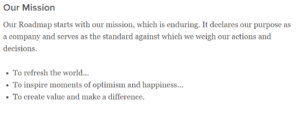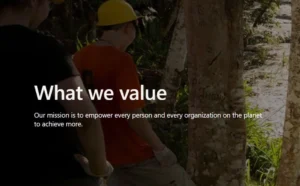What’s the secret ingredient to company success? Every company you ask will have a different answer, but we’ve noticed that being mission-driven tends to help people rise above the rest because the customer can identify with the brand and align themselves with those values.
It’s why Coca-Cola sometimes advertises the fun you have with friends while you happen to have a sip. Other times you hear about ingredients, environmental messaging, and what its company does for local communities. Looking at its current efforts, you’ll see a significant focus on the things that people enjoy, which is wide and varied.
The reason for this is because Coke is using its mission statement to guide its efforts. The company is a notable example of being mission-driven to achieve a wide range of goals for sales, customer acquisition, and customer loyalty.
They’re still focused on selling, and so are you. However, the mission-driven approach takes a step back from the hard sell and attempts an emotional connection with customers and employees.
 When a company is driven by a mission, it is aiming to solve a specific problem. It was created around a topic and uses its mission statement to clearly define that need as well as its path to a solution. The mission statement is the smart place to get started.
When a company is driven by a mission, it is aiming to solve a specific problem. It was created around a topic and uses its mission statement to clearly define that need as well as its path to a solution. The mission statement is the smart place to get started.
Why Do Companies Have a Mission Statement?
Mission statements guide some of the most popular and successful companies on the planet. In the tech space, people often think about Microsoft, Google, and even Facebook. These companies have built out a specific framework to help guide their products, services, and development.
Mission statement: A selective few words that set your path.
Mission statements are designed to showcase what your company will do and how customers, the general public, and your employees should see it. It is a guiding statement that shares your values and purpose as well as highlights target markets and your public image.
Take your time when creating a mission statement, because it’ll be something your business needs to grow. It’s also something outside groups and internal teams use to:
- See if your values match theirs
- Understand your approach to problems and their solutions
- Define company culture
- Check to see if you’re consistent over the long term
- Know what ideas you might be receptive to
- Drive action internally and within your community
Every effort a company takes should be guided by its mission statement. That way, employees and customers always know what to expect.
Writing a Clear Mission Statement
You want your mission statement to be a clear, powerful statement of who you are and what you do. It doesn’t need to be overly long or complicated, and many major companies have broad goals that align all of their industries.
To craft a useful mission statement, answer two questions:
- Why does the business exist?
- What makes your mission different from others?

You don’t have to use those direct words either. LinkedIn makes the case that its connections make you a better worker without telling you how. The goal is clear, and you as the audience or user are left to decide if LinkedIn is accomplishing it.
These messages are a mix of reality (what the company does) and their hope (the benefit it aims to give customers). You’re able to see the value that the company aims to create, understand how they measure it, and judge if it relates to the business at hand.
When you’re ready, start by brainstorming. It takes a lot of work to distill your mission, your reason for existing, down to just a line or two. Make lists of your goals, values, capabilities, and inspiration. Then, use those to build your final mission statement. If you’re at the writing stage, keep these few things in mind:
- Short and sweet comments are easy to understand and judge, without painting you into a corner
- Think about your business in the big-picture sense so that your mission statement reflects long-term planning and thinking
- Write with the idea of change — whether that comes from product shifts, new markets, or reactions to the culture
- If you end up with an extended essay, break it down into your mission, vision, and values
- Ask employees, friends, and customers to read it and see if they understand what it means for how you want your business to operate
Becoming Mission-Driven
After crafting a mission statement, it’s time to let that lead your development and business operations. That’s a bit easier said than done. Education is a crucial factor here.
Start with company-wide announcements and meetings to explain the mission. Ask executives and managers to come prepared with their thoughts on how to further that mission relative to your business. Get feedback and be especially mindful of when your team needs clarification.
Next, review how this impacts your customers. What do they need to know now? How is your relationship going to change? What can they expect?

Your superpower here is empathy. When a mission takes the customer into account, and your review of its implementation works directly with customers, empathy can ensure the changes go well. Empathy inspires loyalty and will encourage your team to interact positively with customers and each other.
Like all significant changes, this must be started by leadership. They need to provide clear examples of how the mission is guiding their decisions, in things both large and small. A commitment to improving the community would need to be seen in how the company markets its services as well as the time or money it (and leadership) give to the local community. This is one reason you see so many of today’s companies organizing efforts to clean up parks, participate in food drives, work with Habitat for Humanity, or donate to local non-profits and charities.
Tips for Mission-Driven Businesses
Mission-driven companies tend to be more resilient thanks to that guiding light for their efforts.
Everyone involved with your organization will know what you value and then can choose to work for you or with you based on that. Relying on a mission to set your goals instead of products or specific customers means that your goals and your products can change without any significant disruption.
If you’re older than six months, the technology you use every day has likely changed. Your new customers likely look different from when you started. The demands and common problems you face have evolved. And, you’re most likely using new processes and practices to accomplish tasks more efficiently.
Mission-driven companies can evolve naturally because the goal is above all of those smaller issues. That means you always start with and return to your mission.
Once you’ve got your eyes on that prize, there are a few steps you can take to ensure everyone knows that your mission drives what you do. Here are some of our favorites.
Broadcast Your Vision
People can only back your mission if they know it. Sharing your vision with employees and customers helps them understand you and your mission. It might enable you to weather a current storm or have people give you the benefit of the doubt when something goes wrong. You only get the bump when people realize your vision matches their values.
Be Transparent in How You Achieve Your Vision
When people consider buying a product, they tend to research it and the company. One thing we all like to see if when a customer has a problem and gets a fast or useful response. We’re looking to see how we’ll be treated if we have an issue.
Those actions are part of a larger transparency request many customers have. Your employees can say things across a wide range of channels that customers can see. Complaints or referrals are also public in many cases. It is easy to review these with an eye toward your mission.
So, if your mission speaks to how you approach customers or your community, demonstrate those efforts in what you do. Being transparent about the sales process, employee management, and when you mess up can be extremely important.
When you make a mistake, being transparent will help your team have an effective dialog and reach a resolution. Admitting the mistake and trying to fix it will help customers engage and put them at ease. You come off like a company made up of people, not a faceless behemoth where concerns disappear into the void.
Treat Everyone Well
Advice around mission-driven organizations often breaks down approaches toward employees and customers into different buckets. However, there’s an overarching theme between these groups: they’re people.
Help when someone needs it, no matter who they are. That can be getting an employee the right job fit or protecting them when there’s a risk. Solving customer issues proactively or making them whole when there’s a mix-up.
Most mission statements are forward-looking and positive. Turn yours into a golden rule and treat everyone the way you would want any person to be treated when they’re trying to accomplish or live out your mission statement.
Listen When Someone Complains
A final touchstone of a mission-driven company is the ability to adapt when there’s a problem. You’ll genuinely be seen as trying to solve a problem — instead of selling a product — when you listen and respond.
There are going to be critics, and they may be crackpots, or they might just be pointing out a major flaw in your operations. Listen closely and carefully to see where their arguments have merit and then respond.
Solving problems brought to your attention today mean that you’ve proactively prevented issues for tomorrow’s customers. A critical review or loud complaint just might hold the key to unlocking better customer service, products, sales, and more.
Marketing Around Your Mission
There are some newer marketing techniques that you can start to review after you have a handle on your missions. The big umbrella is mission-driven marketing that highlights your mission in all of your marketing. It is used to promote your company’s purpose instead of products, hoping to make a greater connection with your customers.
As the Harvard Business School puts it: Customers aren’t just walking wallets.
That’s why we all see marketing that speaks to larger missions and ideologies. Themes people discuss include corporate social responsibility, green pledges and goals, community initiatives, donations, social entrepreneurship and assistance, and campaigns that discuss the state of the current society or community.

Gillette’s take on toxic masculinity is one of the most high-profile examples and the ad continues to generate earned media for the brand. Putting the politics behind the message aside, you can see a significant increase in coverage from the moment the ad campaign launched through its latest quarterly earnings. Publications that never covered market performance for the razor company (which has generally been losing market share since 2011, so the ad backlash may or may not be having any realistic impact).
Show Your Mission Clearly
Zight (formerly CloudApp) is focused on generating video to provide clearer, stronger communication. Few places see that need more than your mission statement. Instead of static words on a page, back them up with the voice of your executives and video of your team living it.
Our mission of revolutionizing team communication is designed around those concepts and needs. We think it shows in our products and services as well as things like our ads.
We’re especially thankful for customers like Jake Bartlett of Atlassian who says Zight (formerly CloudApp) is “always there for me when I need it.” Since we’re big on seeing is believing, you can try us out with no obligation or risk starting right now.

